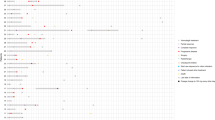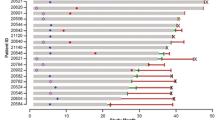Abstract
Background
Vismodegib is indicated for the treatment of advanced or metastatic basal cell carcinoma (BCC). The predictive factors of response to vismodegib have so far been poorly described.
Objectives
The primary objective was to determine the profile of patients responding to vismodegib and the duration of response. Secondary objectives were to assess whether there is a correlation between the duration of treatment and the risk of relapse, and to define factors associated with relapse.
Materials & Methods
We included 61 patients with locally advanced BCC (laBCC) or multiple BCC, treated with vismodegib (150 mg per day), from July 2011 to November 2015, in the Oncodermatology Department of Nantes University Hospital in France. Tumour response was assessed using Response Evaluation Criteria in Solid Tumours version 1.1.
Results
Thirty-nine patients had advanced BCC (64%) and 22 patients multiple BCC (36%), including 10 patients with Gorlin syndrome. No factor predicted response to vismodegib. The median progression-free survival (PFS) was 69.5 months for the total population. In multivariate analysis, multiple BCC was the only factor associated with an increased risk of relapse (HR: 13.80 [CI95%, 1.93–98.64, p < 0.01]). Treatment duration decreased the risk of relapse (HR 0.95 [CI95%, 0.90–0.99, p = 0.0467]). Among the 20 patients who experienced relapse during follow-up, 15 (75%) were re-treated with vismodegib, with a response rate of 66%.
Conclusion
Although we were unable to establish predictive factors for the response to vismodegib, we demonstrate for the first time that increased treatment duration correlates with a decreased risk of relapse.
Similar content being viewed by others
References
Cameron MC, Lee E, Hibler BP, et al. Basal cell carcinoma. J Am Acad Dermatol 2019; 80: 321–39.
Marzuka AG, Book SE. Basal cell carcinoma: pathogenesis, epidemiology, clinical features, diagnosis, histopathology and management. YaleJBiol Med 2015; 88: 167–79.
Rubin AI, Chen EH, Ratner D. Basal-cell carcinoma. N Engl J Med 2005; 353: 2262–9.
Amici JM, Battistella M, Beylot-Barry M, et al. Defining and recognising locally advanced basal cell carcinoma. Eur J Dermatol 2015; 25: 586–94.
Goldenberg G, Karagiannis T, Palmer JB, et al. Incidence and prevalence of basal cell carcinoma (BCC) and locally advanced BCC (LABCC) in a large commercially insured population in the United States: a retrospective cohort study. J Am Acad Dermatol 2016; 75: 957–66.
Lacouture ME, Dréno B, Ascierto PA, et al. Characterization and management of hedgehog pathway inhibitor-related adverse events in patients with advanced basal cell carcinoma. Oncologist 2016; 21: 1218–29.
Lorusso PM, Jimeno A, Dy G, et al. Pharmacokinetic dosescheduling study of hedgehog pathway inhibitor vismodegib (GDC-0449) in patients with locally advanced or metastatic solid tumors. Clin Cancer Res 2011; 17: 5774–82.
Tang JY, Mackay-Wiggan JM, Aszterbaum M, et al. Inhibiting the hedgehog pathway in patients with the basal-cell nevus syndrome. N Engl J Med 2012; 366: 2180–8.
Sekulic A, Migden MR, Oro AE, et al. Efficacy and safety of vismodegib in advanced basal-cell carcinoma. N Engl J Med 2012; 366: 2171–9.
Basset-Séguin N, Hauschild A, Kunstfeld R, et al. Vismodegib in patients with advanced basal cell carcinoma: Primary analysis of STE-VIE, an international, open-label trial. Eur J Cancer 2017; 86: 334–48.
Dréno B, Kunstfeld R, Hauschild A, et al. Two intermittent vismodegib dosing regimens in patients with multiple basal-cell carcinomas (MIKIE): a randomised, regimen-controlled, double-blind, phase 2 trial. Lancet Oncol 2017; 18: 404–12.
Chang ALS, Solomon JA, Hainsworth JD, et al. Expanded access study of patients with advanced basal cell carcinoma treated with the Hedgehog pathway inhibitor, vismodegib. J Am Acad Dermatol 2014; 70: 60–9.
Castillo J-M, Knol A-C, Nguyen J-M, Khammari A, Saint-Jean M, Dreno B. Immunohistochemical markers of advanced basal cell carcinoma: CD56 is associated with a lack of response to vismodegib. Eur J Dermatol 2016; 26: 452–9.
Herms F, Lambert J, Grob J-J, et al. Follow-up of patients with complete remission of locally advanced basal cell carcinoma after vismodegib discontinuation: a multicenter French study of 116 patients. J Clin Oncol 2019; 37: 3275–82.
Apalla Z, Spyridis I, Kyrgidis A, et al. Vismodegib in real-life clinical settings: a multicenter, longitudinal cohort providing long-term data on efficacy and safety. J Am Acad Dermatol 2021; 85: 1589–92.
Verkouteren BJA, Wakkee M, Reyners AKL, et al. Eight years of experience with vismodegib for advanced and multiple basal cell carcinoma patients in the Netherlands: a retrospective cohort study. Br J Cancer 2021; 124: 1199–206.
Eisenhauer EA, Therasse P, Bogaerts J, et al. New response evaluation criteria in solid tumours: revised RECISTguideline (version 1.1). Eur J Cancer 2009; 45: 22847.
Chebassier N, El Houssein O, Viegas I, Dréno B. In vitro induction of matrix metalloproteinase-2 and matrix metalloproteinase-9 expression in keratinocytes by boron and manganese. Exp Dermatol 2004; 13: 484–90.
Saintes C, Saint-Jean M, Brocard A, et al. Development of squamous cell carcinoma into basal cell carcinoma under treatment with Vismodegib. J Eur Acad Dermatol Venereol 2015; 29: 1006–9.
Sekulic A, Migden MR, Basset-Seguin N, et al. Long-term safety and efficacy of vismodegib in patients with advanced basal cell carcinoma: final update of the pivotal ERIVANCE BCC study. BMC Cancer 2017; 17: 332.
Xie P, Lefrancois P. Efficacy, safety, and comparison of sonic hedgehog inhibitors in basal cell carcinomas: a systematic review and meta-analysis. J Am Acad Dermatol 2018; 79: 1089–100.
Flohil SC, van der Leest RJT, Arends LR, de Vries E, Nijsten T. Risk of subsequent cutaneous malignancy in patients with prior keratinocyte carcinoma: a systematic review and meta-analysis. Eur J Cancer 2013; 49: 2365–75.
Author information
Authors and Affiliations
Corresponding author
Additional information
Funding sources
none
Conflicts of interest
none
About this article
Cite this article
Juzot, C., Isvy-Joubert, A., Khammari, A. et al. Predictive factors of response to vismodegib: a French study of 61 patients with multiple or locally advanced basal cell carcinoma. Eur J Dermatol 32, 401–407 (2022). https://doi.org/10.1684/ejd.2022.4264
Accepted:
Published:
Issue Date:
DOI: https://doi.org/10.1684/ejd.2022.4264




